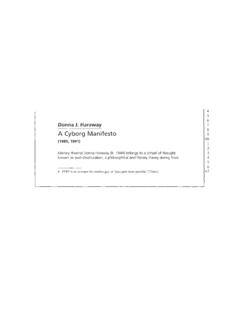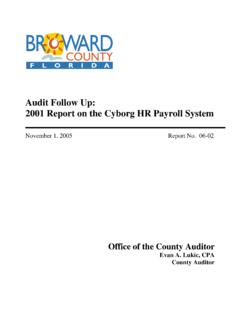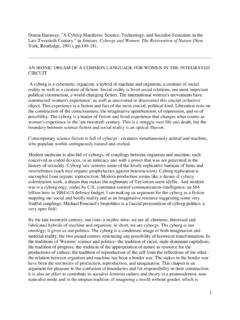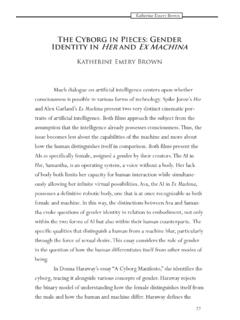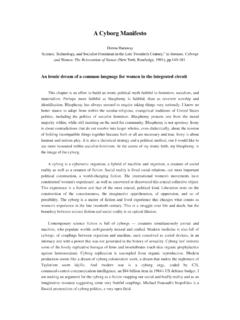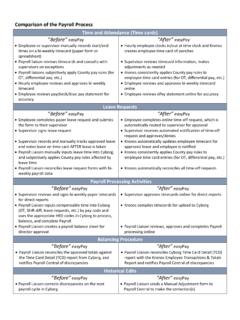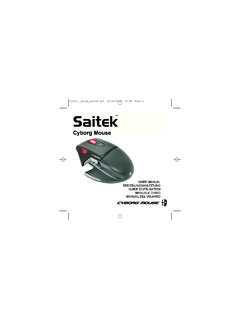Transcription of Cyborg Phenomenology: Performative Inquiry in a ...
1 Liminalities: A Journal of Performance Studies Vol. 10, No. 2 (2014) ISSN: 1557-2935 < > Cyborg phenomenology : Performative Inquiry in a Technoscientific World Shauna M. MacDonald Technoscience and posthumanism point to paradigmatic shifts that require innovative methodological thinking in terms of the questions they pose. In this essay and digital diffraction, drawing from my own performance work, I detail a methodology for examining lived experience within a technoscientific lifeworld. Turning to phenomenology as a philosophical approach, I argue for a posthuman methodol-ogy called Cyborg phenomenology . I then outline a series of phases through which scholars of perfor-mance and artistic Inquiry might move in order to gain an understanding of posthuman, technoscien-tific experience, and attempt to exemplify the methodology through phenomenological writing and the use of digital performance as one set of diffracted findings.
2 The shifting existential, political, and social paradigms we are experiencing require new modalities of reflection, which need to occur, in effect, out on a limb, reaching beyond our existing methods and approaches while maintaining relevance to our lives. (Susan Kozel 8) Diffraction #1: Re-Entry It s over, the voice was saying. The fog receding, the room came into focus. I removed the mask but stayed kneeling, clinging to the vestiges of that other space-time. I had never been in so deep; the exit could only be described as disorienting. This world is louder, brighter harsh. (Once you ve made this kind of journey, it s home that feels foreign). Staring down at the mural, the paint on my (her?) hands, the carpet leaving ridges in my knees, I breathe back into myself and search for the words.
3 Finding them lacking, I just smile as I stand and begin to disinvest myself of the trappings of transport. I rub my eyes and cradle my breasts, willing my body to expand back into its human fluid-ity and fullness (contracting to fit the avatar leaves an imprint) and wonder how to report on this evening s expedition. (Language is the detritus of possibility left by the implosion of the virtual word pieces turn up everywhere.) Shauna M. MacDonald ( , Southern Illinois University) is Assistant Professor in the Department of Communication at Villanova University, where she teaches courses in Perfor-mance Studies and Qualitative Research in Communication.
4 The author thanks Dr. Craig Gin-grich-Philbrook for his guidance for the dissertation project from which this springs, as well as those who have reviewed this manuscript in its various stages. Shauna M. MacDonald Cyborg phenomenology 2 When I open my mouth to speak, her words tumble from that space at the base of my neck, mixing with my own in a double-voiced duet, each of us inhaling the pieces and setting them aflame. (I gather the ashes and carry them home as ink.) The writing, when it comes, is halting and often as gray as the ashes from which it springs. But she and I, we must story our experience, if for no other reason than to understand the holograms (uncanny mirrors) we found as we turned space-time corners together. Diffracted mosaic of light and dark, of hard cold and warm wet, of disembodied voice and electronic touch, of confusion, love, revulsion, desire, symbiosis, violation, fear, song, care, breath, life, a vortex in a vacuum, the inside of the implosion, the echo of the violent clash of personae.
5 These are the things little cyborgs are made of. We danced, she and I. We held hands somewhere on the inside, diving to the depths of networks unseen, grafting intentionalities directed towards the others we found witnesses witnessing witnesses. They danced before us, a parade of questions veiled beneath the shields of identity constructions. We swayed before them, serpents in a trance, meeting them with uncanny attention. They disappeared, but not before shedding codes for us to enter, holographic hall-ways to the human. The fabric torn, flickering became us. Uncanny mirrors held us in one state or another, for a time. We became she, locked in the dance with X, became I, nervous in Cyborg skin, became she, painting with she, became I, willing mouth to inhale and lungs to fill, became she, became I, became we, became becoming.
6 You learn to love the infinite regress of your own limits; you hunger for deeper connection because connection alone is the now; you hear desire with double vision that pulls you ever toward the uncan-ny, because that s where the possibility lives. You (dis)appear. It feels like flying, like the soaring of dreams but in the waking space-time of virtual lifeworlds. It feels like a world-sized gravity-defying carnival ride, but you re the operator, dancing on the ceiling, while riders rotate around you, unaware of the wondrous, violent forces holding them up. It feels like walking through a locked door, shooting from a cannon, breaking the surface of blue water an experience of breaking through. You want to live there, to let your life become the next science fiction novel. And then the voice brings you back.
7 But it s not over. (It could never be over.) She lives at the base of your neck; she calls you to dance. Your skin is a mosaic, a kaleidoscope of code. The remnants of the implosion protrude from your being, leak from your pores. The words set fire to the map, leaving tracings to light your lines of flight. You flicker, you breathe, you become. (You hope others are watching.) You wait for your turn, Performing (Our Way Through) Technoscience Donna J. Haraway argues that the billions of people on our planet who live surround-ed and affected by technology have been interpellated, whether we like it or not, into what she calls technoscience (Modest 49). We have been thrust into human-animal-technological relations as vast as they are dense that condition our being.
8 As one node in this network, I need only look to my smart phone to see that I am at 1 The theoretical terms alluded to here come from the following sources: diffraction (Hara-way, Modest), flickering signifiers (Hayles), double vision (Haraway, Modest), the uncanny (Freud), lines of flight (Deleuze and Guattari). Shauna M. MacDonald Cyborg phenomenology 3 once connected to the possibilities of social networks, scientific discovery, democratic media production, digital art (etc.), as well as to the dark machinery supporting them the digital divide, censorship, propaganda, sweat shop mass production, and mineral mining (to name a few).
9 My use of this example is itself conditioned by a technoscien-tific tendency to view technology from an instrumentalist and progressive point of view, and runs the risk of reducing a complex web of relations to a set of material tools marching toward unquestioned obsolescence. A more nuanced understanding of technology includes those materials we label tools, the processes by which we relate to them, and the socio-historical conditions of their becoming in relation to one an-other. In a technoscientific world, technology can be thought of through the idea of a machinic assemblage, approached, in Gordon Coonfield s words, not [as] a thing, but as a process, an ongoing organizing of multiplicities, or relations between ele-ments and forces, that produces affects (290).
10 2 In technoscience, technology in-dexes varied and transforming sets of relations among shifting organisms, objects, and processes. For some thinkers, technoscientific consciousness coincides with a philosophical shift toward posthumanism. A discourse concerned with the convergence of biology and technology (Pepperell iv), posthumanism allows for a rethinking of human values, human rights and human dignity (Gane 434). Such questioning is necessary as we navigate technoscientific webs that blur the boundaries between human and ani-mal, animal-human (organism) and machine, and the physical and non-physical (Haraway, Simians 151-53) and transform our environments into mash-ups of the digi-tal and the analog, of chaos and continuity. Posthumanism interrogates these trans-formations without reinforcing the humanist assumptions they explode.
